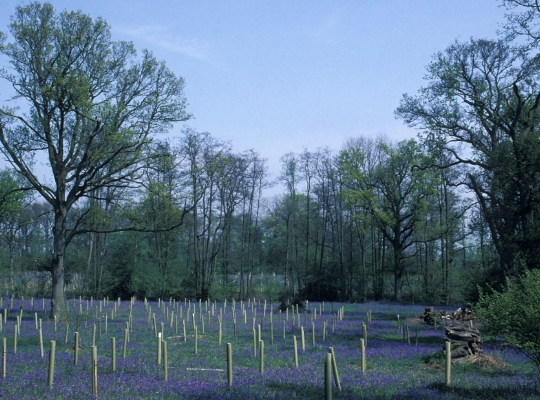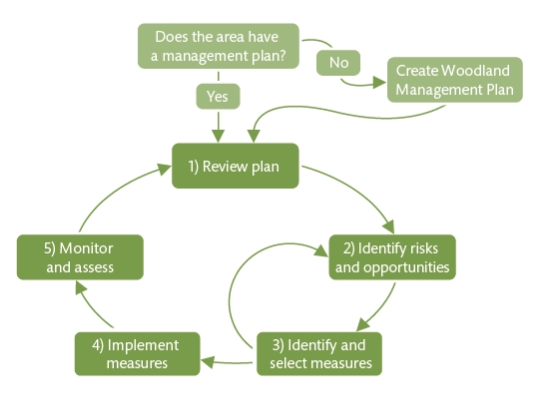Considering forest and woodland design
The design and planning of new woodlands provides an opportunity to incorporate resilience to climate change at the heart of forest management.
Adaptation measures can be incorporated into plans for existing forests and landscapes, as part of the long-term vision and ongoing management, with some measures suitable after thinning or harvesting. Planning the expansion of and connectivity between existing woodlands, especially ancient woodlands, offers added value through supporting the resilience of woodland biodiversity.
Woodland creation and expansion
Creating new woodland
As well as an important climate change mitigation measure, woodland creation can also form part of a wider adaptation strategy by providing flood protection and reducing soil erosion. New woodlands can also provide shade and shelter for people or livestock and help increase biodiversity.
The design and planning of new woodlands provides an opportunity to incorporate resilience to climate change at the heart of forest management. All the adaptation measures described can all be included at this stage.
Climate change risks should be considered during site selection and assessment of suitability for woodland, including assessment of risks and benefits to and from surrounding habitats, such as wildfire. Woodland creation offers the opportunity to reduce risk exposure (likelihood) and hazard (severity), by avoiding high risk areas – which is not available to existing woodlands.
The UK Forestry Standard explains the regulatory framework for new woodland creation and our funding and support page provides information on government assistance.

Expanding existing woodland
Woodland expansion provides an opportunity to select an appropriate mix of ecologically suited species and provenances, which would help increase resilience to climate change and be beneficial to wildlife through increased habitat connectivity. However, there is anecdotal evidence that the risk of pests and diseases and the spread of invasive species may be increased with larger and better-connected forests and woodlands.
Forest design and planning
The forest management plan should consider the wider physical landscape, along with social, economic and environmental factors. The plan needs to consider the long-term vision and management objectives and sets out how silvicultural management will achieve them. Forest planning is the primary route to incorporating adaptation measures in forest management. Decisions about species and provenance choice, species diversity, establishment method, silvicultural management, structural diversity, thinning regime, and infrastructure design are all considered within the forest design plan. Having a forest management plan is a precursor to the 5-step adaptation framework.
Guidance notes
- Site surveys are important to identify vulnerability to the changing climate and an Environmental Impact Assessment may be required.
- Forest management plans should lay out which adaptation measures are being applied.
- Specific guidance is available to support woodland creation on brownfield sites which can present a unique set of challenges – see best practice guidance for land regeneration.
- For further advice see the UKFS Practice Guide ‘Adapting forest and woodland management to the changing climate’.
Download the UKFS Adaptation Practice Guide
Printed copies are available to purchase from Forest Research.
"*" indicates required fields
Reducing climate change risks
The following risks may be reduced if the adaptation measure is applied appropriately:
Tools to assist decision-making
A free online tool for woodland mapping and management planning by the Sylva Foundation. Scottish Forestry and Forestry Commission woodland management plan templates available.
The Forest Research Ecological Site Classification tool incorporates future climate change projections and helps managers to select tree species that are ecologically suited to particular sites.




